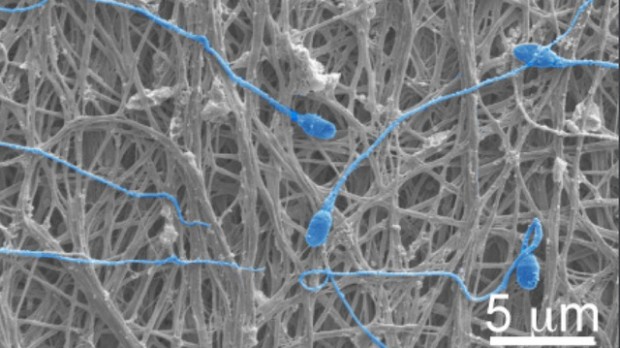Sex often fuels the adoption of cutting-edge technology, even in the burgeoning field of nano-fabrication. Researchers at the University of Washington have just published a paper in PLoS One describing how they’ll use “electrospinning” to create next-generation female condoms made from specially customized nano-fibers.
According to a release about the study from University of Washington:
Electrospinning uses an electric field to catapult a charged fluid jet through air to create very fine, nanometer-scale fibers. The fibers can be manipulated to control the material’s solubility, strength and even geometry. Because of this versatility, fibers may be better at delivering medicine than existing technologies such as gels, tablets, or pills.
Basically, the researchers’ proposal is to spin ultra-thin female condoms woven out of cloth-like fibers and medicine. Above, you can see a magnified image of the resulting condom, complete with sperm who have tried to smash their way through it and failed miserably.
The condoms can be woven out of medicines that prevent HIV infections, providing protection against disease while also stopping sperm in their tracks. The electrospun condoms can be designed to dissolve within minutes, or over a period of several days. Women can discreetly put them on before a sexual encounter — either directly, or on a diaphragm or ring — and protect against pregnancy, HIV, and potentially other sexually transmitted diseases as well.
Write the researchers in their abstract:
Multipurpose prevention technologies (MPTs) that simultaneously prevent sexually transmitted infections (STIs) and unintended pregnancy are a global health priority. Combining chemical and physical barriers offers the greatest potential to design effective MPTs, but integrating both functional modalities into a single device has been challenging. Here we show that drug-eluting fiber meshes designed for topical drug delivery can function as a combination chemical and physical barrier MPT. Using FDA-approved polymers, we fabricated nanofiber meshes with tunable fiber size and controlled degradation kinetics that facilitate simultaneous release of multiple agents against HIV-1, HSV-2, and sperm. We observed that drug-loaded meshes inhibited HIV-1 infection in vitro and physically obstructed sperm penetration. Furthermore, we report on a previously unknown activity of glycerol monolaurate (GML) to potently inhibit sperm motility and viability. The application of drug-eluting nanofibers for HIV-1 prevention and sperm inhibition may serve as an innovative platform technology for drug delivery to the lower female reproductive tract.
The researchers have just received a $1 million grant from the Bill and Melinda Gates Foundation to develop the technology.
——————————————————————————–
Source : io9.






